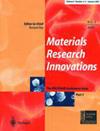高可重复利用moo3基染料快速降解催化剂的仿生合成
Q2 Engineering
引用次数: 1
摘要
近几十年来,人们一直致力于可持续设计和合成具有可控形态和结构复杂性的过渡金属氧化物基光催化剂,以提高其催化性能。在这篇文章中,我们报道了生物燃料辅助水热合成MoO3、MoO3:NiO和MoO3:PdO/Pd作为催化剂从水溶液中去除偶氮污染物。选择甲基橙作为代表有机污染物的模型染料。本文提出了一种通过引入NiO和PdO来提高MoO3可见光催化活性的简便方法。当太阳光照MoO3:NiO和MoO3:PdO/Pd时,NiO和PdO的氧空位产生的辐射协同参与了MoO3的催化反应,在15 min内分别降解了98%和95%的甲基橙。为了证实NiO和PdO对MoO3催化的支持作用,我们在黑暗环境条件下进行了催化实验,只有催化剂(没有刺激物)。随后,MoO3:PdO和MoO3:NiO的降解效率分别从MoO3的62%提高到73%和84%,这表明NiO和PdO大大提高了MoO3在黑暗条件下的效率,并且通过光诱导可见光降解几乎完全去除甲基橙。此外,光催化剂具有良好的可重复使用性,直到四次实验,其降解效率没有下降。因此,本研究的整体催化结果高度推荐MoO3:PdO和MoO3:NiO作为水修复的优秀光催化剂。本文章由计算机程序翻译,如有差异,请以英文原文为准。
Biomimetic Synthesis of Highly Reusable MoO3-based Catalysts for Fast Degradation of Dyes
Over the recent decades, unrelenting efforts are being devoted to the sustainable design and synthesis of transitional metal oxide-based photocatalysts with controlled morphology and structural complexity to enhance their catalytic properties. In this account, we have reported the bio-fuel-assisted hydrothermal synthesis of MoO3, MoO3:NiO, and MoO3:PdO/Pd as catalysts to remove azo pollutants from an aqueous solution. Methyl orange was selected as the model dye to represent organic pollutants. This work presents a facile method for improving the visible-light-driven catalytic activity of MoO3 by introducing NiO and PdO. When MoO3:NiO and MoO3:PdO/Pd were illuminated by solar light, emitted radiation originating from oxygen vacancies of NiO and PdO synergistically participated in catalytic reactions of MoO3 giving 98% and 95 % degradation of methyl orange, respectively, in 15 min. To confirm the supporting role of NiO and PdO in the catalysis of MoO3, catalytic experiments were carried out in dark ambient conditions, with only catalysts (without stimulants). Subsequently, the degradation efficiency of MoO3:PdO, and MoO3:NiO was increased to 73% and 84% respectively, from 62 % efficiency of MoO3 suggesting that NiO and PdO greatly increased the efficiency of MoO3 in dark conditions and nearly complete removal of methyl orange by photo-induced visible light degradation. Furthermore, the photocatalysts illustrated good reusability till four runs of experiments without loss in its degradation efficiency. Therefore, the overall catalytic results of the current study are highly proposing MoO3:PdO and MoO3:NiO as excellent photocatalysts for water remediation.
求助全文
通过发布文献求助,成功后即可免费获取论文全文。
去求助
来源期刊

Materials Research Innovations
工程技术-材料科学:综合
CiteScore
5.20
自引率
0.00%
发文量
38
审稿时长
2.8 months
期刊介绍:
Materials Research Innovations covers all areas of materials research with a particular interest in synthesis, processing, and properties from the nanoscale to the microscale to the bulk. Coverage includes all classes of material – ceramics, metals, and polymers; semiconductors and other functional materials; organic and inorganic materials – alone or in combination as composites. Innovation in composition and processing to impart special properties to bulk materials and coatings, and for innovative applications in technology, represents a strong focus. The journal attempts to balance enduring themes of science and engineering with the innovation provided by such areas of research activity.
 求助内容:
求助内容: 应助结果提醒方式:
应助结果提醒方式:


